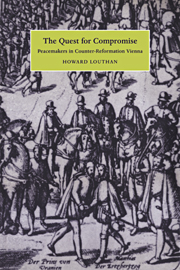Book contents
- Frontmatter
- Contents
- List of illustrations
- Acknowledgments
- A political and cultural chronology
- List of abbreviations
- Introduction
- PART I THE EMERGENCE OF AN IRENIC COURT
- PART II MAXIMILIAN II AND THE HIGH POINT OF IRENICISM
- Introduction
- 3 Hugo Blotius and the intellectual foundation of Austrian irenicism
- 4 Ordering a chaotic world: the reformation of the imperial library
- 5 Protestant ecumenism and Catholic reform: the case of Johannes Crato
- 6 Finding a via media: Lazarus von Schwendi and the climax of Austrian irenicism
- PART III THE FAILURE OF IRENICISM
- Conclusion: Storm clouds on the horizon: from the great milk war to the Thirty Years War
- Epilogue: The wider circle of irenicism
- Select bibliography
- Index
- CAMBRIDGE STUDIES IN EARLY MODERN HISTORY
4 - Ordering a chaotic world: the reformation of the imperial library
Published online by Cambridge University Press: 03 December 2009
- Frontmatter
- Contents
- List of illustrations
- Acknowledgments
- A political and cultural chronology
- List of abbreviations
- Introduction
- PART I THE EMERGENCE OF AN IRENIC COURT
- PART II MAXIMILIAN II AND THE HIGH POINT OF IRENICISM
- Introduction
- 3 Hugo Blotius and the intellectual foundation of Austrian irenicism
- 4 Ordering a chaotic world: the reformation of the imperial library
- 5 Protestant ecumenism and Catholic reform: the case of Johannes Crato
- 6 Finding a via media: Lazarus von Schwendi and the climax of Austrian irenicism
- PART III THE FAILURE OF IRENICISM
- Conclusion: Storm clouds on the horizon: from the great milk war to the Thirty Years War
- Epilogue: The wider circle of irenicism
- Select bibliography
- Index
- CAMBRIDGE STUDIES IN EARLY MODERN HISTORY
Summary
The origins of the imperial library in Vienna can be traced back at least to the fourteenth century. Duke Albert III (1365–1395) was an avid collector of manuscripts, but Emperor Frederick III (1440–1493) laid the real foundations of the collection in the fifteenth century. Through the leadership of Aeneas Sylvius Piccolomini and George von Purbach the manuscript collection grew after the fall of Constantinople with the addition of Greek and Latin codices secured from Byzantium, and with Gutenberg's invention a new medium was added to the library. In the early part of the sixteenth century the library increased its inventory with contributions from Vienna's humanist community and the acquisition of a portion of Matthias Corvinus's collection. The marriages of Maximilian I were not only shrewd dynastic moves for the Habsburgs. Both Mary of Burgundy and Bianca Maria Sforza also brought important manuscripts to the growing Austrian collection.
After the death of Maximilian I in 1519 Vienna lost much of its strategic importance. The imperial court would not permanently return to the city until 1558. The low point for Vienna came in 1529 when it was almost lost to the Turk. During these troubled years Ferdinand appointed a number of officials to oversee the library. These men cared for the imperial collection on an informal basis, for the post of librarian was generally considered an ancillary office at court. Once Blotius secured this position, however, he effectively used this forum to express the ideals of Vienna's irenic circle. Blotius's vision for the library was a product of his broader perspective of the confessional crisis of the late sixteenth century.
Information
- Type
- Chapter
- Information
- The Quest for CompromisePeacemakers in Counter-Reformation Vienna, pp. 67 - 84Publisher: Cambridge University PressPrint publication year: 1997
